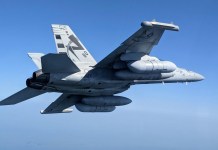As the F-35 stealth jets could confront Russian fighters at some point in Europe, the plane and its design were a direct derivative of a former Soviet Union project that could not be completed when the Communist superpower collapsed – the Yakovlev Yak-141.
War In Ukraine Has ‘Dramatically Revived’ Global Nuclear Industry, But The Same War Can Kill It Too
The Short/Vertical Take-Off and Landing (SVTOL) F-35B naval variant could be called a direct derivative of the Yak-141.
The Russian company had turned to Lockheed Martin in 1991 following the USSR’s dissolution to fund around $350 million when a weakened Russia was trying to normalize ties with Washington.
It is reflected in the single vectoring nozzle located behind the center of gravity and dedicated vertically positioned thrust jets just behind the engine of the Yak-141 that is shared by the F-35B.

Design began in 1975 after the Soviet Navy contracted Yakovlev to develop a VTOL aircraft capable of fleet air defense. Led by famous aeronautical designer Alexander Yakovlev and his impressive Yak 141, they almost did it. The remarkable machine boasted four prototypes and broke several world records.
At the height of the cold war in the 1960s, the British Hawker Siddeley Harrier, both in its land-based and naval versions, was a famous fighter.
The Soviet Union first created the Yakovlev Yak-36′ Freehand’ with four prototypes. The Yak 38 ‘Forger’ eventually entered production and served the Soviet Navy with over 200 examples.
Nevertheless, the model was limited in its payload capacity and overall performance. This was partly because Yakovlev’s aircraft designer and manufacturer always considered the Yak-38 a mere step in developing an advanced VTOL aircraft.
Design
The Soviet Navy wanted the new VTOL aircraft to compensate for the Yak-38’s shortcomings – sustained supersonic speed, maneuverability, agility, radar, and weapons loads.
With unprecedented technical challenges in the design, more than ten chief engineers were pressed into service. The challenge was providing both supersonic performance and maintaining vector thrust capability.
Engineers finally adopted a single engine configuration since an engine lost during landing would cause an immediate roll to the side in twin-engine designs. Thus, designers finally settled for a single vector in the nozzle behind the center of gravity.
Dedicated vertical thrust jets were also positioned behind the cockpit. In contrast, the forward thrust and lifting was a jet pipe at the rear turning up and down to 90 degrees for VTOL maneuvers – an arrangement that would later be seen on the F-35B.
The airframe was designed around a single engine concept with a circular nozzle between twin booms, supporting the distinctive twin fin tail straddling both sides of the engine installation.
The remaining sections of the Yak-4 shared features with other famous Soviet jets like the Mikoyan Gurevich MiG-25 and MiG-31. These were a slab-sided forward fuselage with rectangular air intakes, and its small area wings were clipped with a marked sweep along their leading edges.
The wings could also be folded to aid carrier storage. Also, essential parts were manufactured in titanium since the excessive heat from the engines during landing was expected to damage the fuselage. The non-critical ones were completed with composites or graphite.
The hovering time was also limited to two and a half minutes to avoid overheating. The engines behind the cockpit meant for VTOL operations were covered with dorsal flaps. They provided the engines with air while the exhaust flew downwards towards the belly and through an opening covered by two ventral doors.
The main powerplant was a Soyuz R-79V-300 turbofan engine capable of 1088-kilogram dry thrust and 15,500-kilogram force with an afterburner. The lift engines behind the cockpit were RD-41 turbojets, providing 4218-kilogram of thrust each.
Performance
The first flight happened on March 9, 1987, and the first hover was successfully attempted two years later, on December 29, 1989.
On June 13, 1990, the last prototype achieved the first complete transition from vertical to high-speed flight to a vertical landing. Finally, the first vertical carrier-based landing was accomplished on September 26, 1991, aboard the Admiral Gorshkov aircraft carrier.
The aircraft showed excellent combat maneuvers, high responsiveness, and kinematic performance for a fighter aircraft of its time. It could reach a maximum speed of Mach 1.4 (1,120 miles per hour), a ferry range of 1,865 miles, and its service range was 1,300 miles.
Its service ceiling crossed well above 50,000 thousand feet, while its rate of climb was 48,215 feet per minute.
Lockheed Martin-Yakovlev Design Bureau Team Up
An October 5, 1991 mishap considerably damaged one of the prototypes. After a hard landing, the aircraft ruptured a fuel tank and was engulfed in fire when the pilot ejected after 30 seconds and was safely rescued from the sea.
And just a couple of months before the USSR collapsed, the Soviet Navy announced there were no more funds to continue with the program. Final series production variants with advanced avionics and Leading Edge Root Extensions (LERX) could never be realized.
Yakovlev Design Bureau, suffering under acute economic distress, was now looking for cold hard cash. And this is where US defense giant Lockheed Martin came in, pouring billions of dollars into the program.
An agreement was signed between the two in 1991, which was not made public until 1995. The fact that the Yak-141 never entered serial production despite Lockheed’s infusion means its interest was solely for the vital testing data from the development and flights – to understand the ‘know why’ behind the technology.
This 1993 document from the National Aeronautics and Space Administration (NASA) admits how access to Soviet VTOL technology was critical for the United States: “Military hardware that had once been highly classified and the basis for our defense planning was now openly marketed at air shows around the world…This environment permitted a visit to the Yakovlev Design Bureau (YAK) for a vertical/short take-off and landing (VSTOL) technology assessment. Yakovlev is the FSU’s sole Design Bureau with experience in VSTOL aircraft and has developed two flying examples, the YAK-38 ‘Forger’ and YAK-141′ Freestyle’.”
The F-35, born out of the Yak-141, is likely to be the spear’s tip in any combat operation against Russia or China. History only repeated itself 20 years later when China’s J-20 was revealed to have borrowed heavily from the F-35 through cyber espionage and hacking.
- The author can be reached at satamp@gmail.com
- Views Personal
- Follow EurAsian Times on Google News




